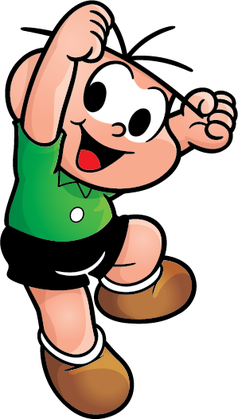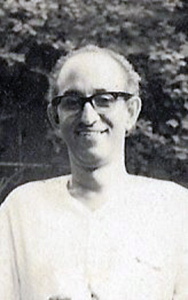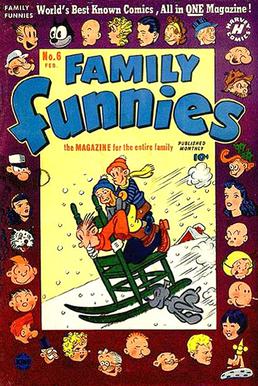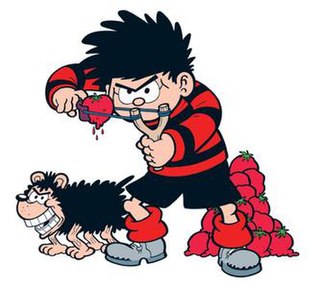
A comic strip is a sequence of cartoons, arranged in interrelated panels to display brief humor or form a narrative, often serialized, with text in balloons and captions. Traditionally, throughout the 20th and into the 21st century, these have been published in newspapers and magazines, with daily horizontal strips printed in black-and-white in newspapers, while Sunday papers offered longer sequences in special color comics sections. With the advent of the internet, online comic strips began to appear as webcomics.

Dilbert is an American comic strip written and illustrated by Scott Adams, first published on April 16, 1989. It is known for its satirical office humor about a white-collar, micromanaged office with engineer Dilbert as the title character. It has led to dozens of books, an animated television series, a video game, and hundreds of themed merchandise items. Dilbert Future and The Joy of Work are among the best-selling books in the series. In 1997, Adams received the National Cartoonists Society Reuben Award and the Newspaper Comic Strip Award for his work. Dilbert appears online and as of 2013 was published daily in 2,000 newspapers in 65 countries and 25 languages.

The Mickey Mouse universe is a fictional shared universe which is the setting for stories involving Disney cartoon characters, including Mickey and Minnie Mouse, Donald and Daisy Duck, Pluto and Goofy as the primary members, and many other characters related to them, being most of them anthropomorphic animals. The universe originated from the Mickey Mouse animated short films produced by Disney starting in 1928, although its first consistent version was created by Floyd Gottfredson in the Mickey Mouse newspaper comic strip. Real-world versions also exist in Disneyland and Tokyo Disneyland, called Mickey's Toontown.

Pearls Before Swine is an American comic strip written and illustrated by Stephan Pastis. The series began on December 31, 2001. It chronicles the daily lives of an ensemble cast of suburban anthropomorphic animals: Pig, Rat, Zebra, Goat, and a fraternity of crocodiles, as well as a number of supporting characters, one of whom is Pastis himself. Each character represents an aspect of Pastis's personality and worldview. The daily and Sunday comic strip is distributed by Andrews McMeel Syndication.
Pibgorn is a webcomic by Brooke McEldowney begun in early 2002. The title character is a fairy whose adventures span the fantasy and real worlds. McEldowney also creates the syndicated comic strip 9 Chickweed Lane, occasionally crossing over to Pibgorn, which explores stronger themes of sexuality and violence.

Baby Blues is an American comic strip created and produced by Rick Kirkman and Jerry Scott since January 7, 1990. Distributed by King Features Syndicate from 1995 until January 2022, and distributed by Andrews McMeel Syndication as of January 2022, the strip focuses on the MacPherson family and specifically on the raising of the three MacPherson children.
Chitrakatha are comics or graphic novels originating from India published in a number of Indian languages.

Jimmy Five, known as Cebolinha in Portuguese, is one of Monica and Friends' main characters. He was created in 1960, at first as a support character for Franklin and Blu who the following year became the protagonist of his own series of newspaper strips, which was later replaced by the character Monica in the 70s. Currently Jimmy Five has his own printed comic book, called Cebolinha, which was first released in 1973.
Batul, Bantul, Batul the Great, or Bantul the Great is a popular Bengali comic strip character created by Narayan Debnath. Bantul the great is originally India's first untelevised superhero. It first appeared and still appears in a children's magazine called Shuktara and is widely read, not only by children but by adults as well. It has since appeared in a comic book format and as an animation series.

Narayan Debnath was an Indian comics artist, writer and illustrator. He created the Bengali comic strips Handa Bhonda (1962), Bantul the Great (1965) and Nonte Phonte (1969). He holds the record of longest running comics by an individual artiste for Handa Bhonda comics series which completed its continuous 53 years of running. He was the first and only comics artist in India who has received a D. Litt. degree. Debnath was awarded Padma Shri, the fourth highest civilian award in India, in the year 2021.

Narayan Gangopadhyay, also known as Narayan Ganguly, was an Indian novelist, poet, essayist, and short story writer, and one of the leading writers of modern Bengali literature. He introduced the endearing character of Tenida in his famous stories of children's literature. He took up "Narayan" as his pen name. He married his brother in law's niece Renuka Devi, with whom he had his only daughter Basabi (Bani). His wife Renuka Ganguly and daughter Basabi Roy Chowdhury were also eminent writers and teachers. Renuka Ganguly died on 10 February 2010 whereas, Basabi Roy Chowdhury recently died on 17 December 2021, and was survived by 6 children, and grandchildren.

Bhajahari Mukhujjee, commonly known as Tenida or Teni, is a fictional native of Potoldanga in Calcutta, who appears in a number of short stories and larger works of the Bengali author Narayan Gangopadhyay. The leader of a group of four young lads who lived in the neighbourhood of Potoldanga, Tenida was depicted as the local big-mouthed airhead, who, although not blessed with academic capabilities, was admired and respected by the other three for his presence of mind, courage, and honesty as well as his vociferous appetite. Descriptions of Tenida's nose also make frequent appearances in the text, being described as "a large nose resembling Mount Mainak". The narrator of the stories is Pyalaram, who seemed to share his leader's frailty in academic exertions. The other two characters who formed an integral part of the quartet were Habul Sen, who speaks with strong East Bengali accent (Dhakai) and Kyabla, the cleverest among the four.
Handa Bhonda, also referred to as Hada Bhoda is a Bengali comic-strip creation of Narayan Debnath, which originally was serialized for the children's monthly magazine Shuktara. The comics have appeared in book form. A popular animation series based on the characters has also been filmed.

Toots and Casper is a family comic strip by Jimmy Murphy, distributed to newspapers for 38 years by King Features Syndicate, from December 17, 1918 to December 30, 1956. The strip spawned many merchandising tie-ins, including books, dolls, paper dolls, pins, bisque nodders and comic books.

Dennis the Menace and Gnasher is a long-running comic strip in the British children's comic The Beano, published by DC Thomson, of Dundee, Scotland. The comic stars a boy named Dennis the Menace and his dog, an "Abyssinian wire-haired tripe hound" named Gnasher.
Notable events of 2022 in comics. It includes any relevant comics-related events, deaths of notable comics-related people, conventions and first issues by title.
Nonte Fonte is a 2023 Indian Bengali-language comedy-drama film directed by Anirban Chakraborti. The film is based on Narayan Debnath's comic strip, Nonte Phonte. The film's screenplay and dialogues were written by Amlan Majumdar, and the music was composed by Anupam Roy. Paran Bandopadhyay, Amlan Majumder, Subhasish Mukherjee and Sumit Samader play the lead roles in the film. The film was released on 19 May 2023.











